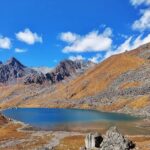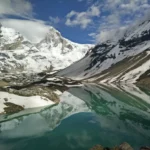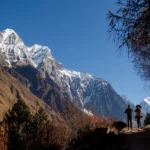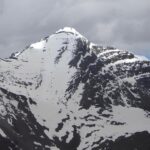Signed up for your first Himalayan Trek and now clueless about trekking essentials and things to pack? Many beginner trekkers are unaware of things to buy or carry on their first Himalayan trek. The information overload often confuses them and end up with expensive gear without understanding the requirements.
Here is the list of must-haves and trekking essentials recommended by our Outdoor Leaders for your Himalayan Trek.
The Must-Haves Trekking Essentials
The following items are essential on any high-altitude trek. These are the must-haves for your trek. If you plan to start shopping or borrowing for your trek, start with this list.
1. Trekking Backpack
I recently visited a Decathlon store to buy a rucksack. The options in just one store were enough to put me in a fix. However, I was aware of the things to remember when investing in a Backpack, and a few tips from an Outdoor Leader came in handy.
If you are going on a weeklong trek, you can settle for a backpack with 50-60 litres capacity. While choosing your backpack, check that the shoulder strap is padded, cushioned, and easy on your shoulders. Another thing to remember is comfortable hip support. As the backpack will be your next closet for the rest of the trek, it ought to be comfortable to carry. Make sure to check that your backpack distributes its load evenly.
Some brands beginners can consider are Quechua and Forclaz by Decathlon, Wildcraft, and Woodland. Don’t forget to check for the sale to grab the backpacks at pocket-friendly rates. Other brands available in the market are Columbia, Osprey, and Deuter. However, these brands are on the higher side. Invest in their products if you are a seasoned trekker and will be using them frequently.
Tip- Do not invest in expensive backpacks if you use them once or twice a year.
2. Trekking Shoes
If the backpack is your closet for a week in the wilderness, think of trekking shoes as your driving force. One gear that will be with you throughout the trek is your trekking shoes. If there is one gear of utmost importance, it has to be your trekking shoes.
There is a range of trekking shoes available in the market – both online and offline. We suggest an offline purchase to find a comfortable fit. Or you can try the shoes at an offline store, and order the same pair online if there is a huge price difference.
Do check for sturdy ankle-length hiking boots, preferably all leather upper as it provides better ankle support. Next, make sure your shoes are waterproof and not just water-resistant. The water-resistant ones exposed to rain get drenched completely while waterproof ones will keep your feet dry for a longer period in case of rain on the trail. Look for a good grip as you will traverse a series of challenging terrain on the trek.
We suggest the MH Series by Decathlon are available in different price ranges. Some other brands available in the market are Quechua by Decathlon, Wildcraft, Woodland, and Columbia.
Outdoor Leaders’ tip- Break into your trekking shoes at least a few days before your Himalayan Trek. Wear it before the trek to get comfortable in your shoes. Following this will prevent blisters on the trek.
At OWLS, it is beyond the regular trekking experience, you will be pitching your tent, and engaging in the kitchen which requires your shoes to be comfortable.
3. Trekking Clothes
Clueless about what to pack for a trek, a lot of beginners end up overpacking. Here is a checklist you need for your Himalayan Trek.
1) Synthetic T-shirt – 02
We recommend our participants carry 3 synthetic dry shirts. This will be your base layer. Wear one and carry two in your backpack. Cotton is not recommended since Himalayan treks demand long walking hours, and you sweat a lot. Cotton takes longer to dry and does not keep you warm.
Make sure the dry-fit t-shirts have full sleeves. You can check out the dry-fit full-sleeved T-shirts from Decathlon, and brands like Kappa and Pefromax have good dry-fit t-shirts. For a pocket-friendly buy, you can check Max and Reliance Trends. Shopper Stop and Lifestyle also have dry-fit t-shirts to choose from.
2) Trek Pants – 02
Two trek pants will be enough for a week-long trek. You can wear one on the trek and save one for changing in case it rains or gets wet. Go for dry-fit ones, as they absorb your sweat easily. You can look for pants with a zipped pocket to keep your phones and some quick snacks handy. Pants that convert into shorts are recommended as they are convenient to wear depending on the weather in the mountains. The zippered pants are also easy while crossing small streams. For trekking pants, Decathlon is our go-to store.
3) Thermal Wear – Upper and Lower (01)
Now that your base layer is sorted, your inner layer or insulation is also a priority on any Himalayan Trek. Carry top and bottom thermal wear. Preferably, made of wool/polypropylene. This will be worn as your first layer. Over this, you can wear a fleece jacket or a thick jacket, depending on how cold it gets.
Tip: Wear thermal only at night or at the campsite. Avoid thermal wear while climbing. Your body will maintain a regular temperature throughout your walk, and keep you warm. Wearing them while walking will be inconvenient and cause you to sweat unnecessarily.
4) Thick Fleece/Sweater – 01
This will be your second layer. The sun is direct and keeps you warm during the daytime. It also gets windy on the trails. During summer treks, you can carry a sweatshirt or a sweater to protect you from the wind. If you are trekking in winter a thick fleece is recommended as an outer layer while walking.
5) Down/Padded Jacket – 01
Carry one outer upper layer (Any down/synthetic jacket). It is required at the campsite or on the summit days when one starts a day early in the morning. You can get them online or at any local market where they sell winter collections. You can invest in a good down jacket if you frequent the outdoors. Decathlon has a range of down jackets, depending on your budget.
Many brands are selling pocket-friendly down jackets online. You can check out brands like Fort Collins and Monte Carlo for their range of padded jackets that keep you warm in harsh winters.
4. Trek Accessories
1) Lightweight tennis shoes/crocs – 01
this should be closed-toe for wearing at the campsite. Make sure it is not slippery, as rain is unpredictable in the mountains and the surface becomes slippery.
2) Socks – 04
3-5 pairs of nylon socks in spring, summer, autumn, and monsoon. These are the types that you wear daily. Make sure it’s not very thin, as you will walk an average of 4-6 hrs a day.
Organize your socks for walking and for wearing at night at the campsite. The pair for use at night can be thicker than day socks.
Add 2-3 pairs of woollen socks if you are planning your trek in winter. Preferably thick wool socks. Always carry an extra pair of shocks. This will come in handy if there is rain on the trek.
3) Sun Cap/ Hat – 01
The cap protects you from direct sunlight high in the mountains. Avoiding sun caps in the outdoors can cause sunstrokes and direct and harsh sun rays can dehydrate you, causing a severe headache on the trek.
4) Sunglasses – 01
Now that you have protected your head and body, your eyes can be sensitive to direct sunlight in the open mountains. As the altitude increases, the share of trees decreases. A pair of sunglasses not only protects you from the sun but also makes it comfortable to climb without any hindrance to your eyes.
5) Cutlery – Lunch Box and Mug
Carry your own set of cutlery on the trek. We motivate our trekkers to experience outdoor life in every possible way, including managing their cutlery. We suggest bringing a spoon, a mug, and a lunch box. Make sure the lunch box you are carrying is airtight and leakproof.
6) Water bottle – 01
Throughout the trek, you need to be hydrated to avoid headaches. Carry a bottle of 2-litre capacity or two of one-litre capacity. Please ensure that they do not leak.
7) Headlamp/ flashlight – 01
You will require the headlamp to go to the washrooms at night. Headlamp keeps your hand free while engaging in activities like pitching a tent, going to the washroom and cleaning your lunch boxes. Carry an extra set of batteries.
8) Rain Gear/Ponchos – 01
The weather in the mountains is unpredictable. You may begin your trek on a sunny morning, but it can turn into a rainy afternoon. A Poncho with sleeves will protect you from the rain. Poncho is convenient to carry and helps you to protect your backpack and your entire body. Rain jackets can be a little heavier than ponchos.
9) Woollen gloves (For Winter Treks) – 01
The gloves keep you warm at the campsite when the temperature drops at night. You require the gloves in the morning when the temperature is on the lower side.
5. Trekking poles
Most Himalayan Treks are week-long. It traverses through mountains to the meadow. The trail is upslope and requires you to ascend and descend at regular intervals. Trekking poles will help you to balance and be steady on these irregular trails. There will be a lot of walking, climbing, and descending the entire trail. For walking comfortably, a trekking pole is a must for any outdoor enthusiast. Every trekker should at least carry one trekking pole. Our Outdoor experts suggest carrying two if possible.
6. Innerwear – As per requirement
Although you can’t bathe on the trek, you can carry them as per your requirement.
Along with the essential hiking equipment, you require a set of supporting accessories which is mandatory for any trek. The trek will be inconvenient and unmanageable without these gears.
7. Personal Medicine Kit-
At OWLS, our Outdoor Leaders are certified and equipped with medicines to assist you in case of medical emergencies. However, if you are taking some specific medicines, we suggest you consult your doctor before packing your medicine kit.
8. Ready to eat snack-
Climbing the mountains continuously for hours is exhausting. It requires you to keep refuelling yourself. Carry snacks like dry fruits, protein bars, and shakkar pada that give instant energy on a tiring day.
Avoid bringing packaged and unhealthy snacks. We at OWLS try to leave no trace in the mountains, and we have zero tolerance for littering in the mountains.
9. Toiletries
A toilet kit with basic items like a toothbrush, toothpaste, sunscreen, lip balm, tissue paper roll, and moisturizer is a must. Try to keep your kit compact and light.
The sun is direct and harsh in the mountains. We recommend a lotion that has a rating of SPF-5 at least to protect from sunburn.
Lip balm is a highly recommended item. The weather is dry in the mountains, making your lips parched even during the summer trek. Carry a regular lip balm you use to moisten your lips regularly. Besides, carrying a small size of these items will make a difference in your backpack’s weight. Do not hoard non-essential items like soaps and shampoos. On the mountain, you will not be able to bathe.
These are the list of items that you must carry on any Himalayan High Altitude Trek. While it is mandatory to have all of these items, you can consider borrowing a few items. In some cities, you can also rent gear. We always recommend renting gear if the option is available.





